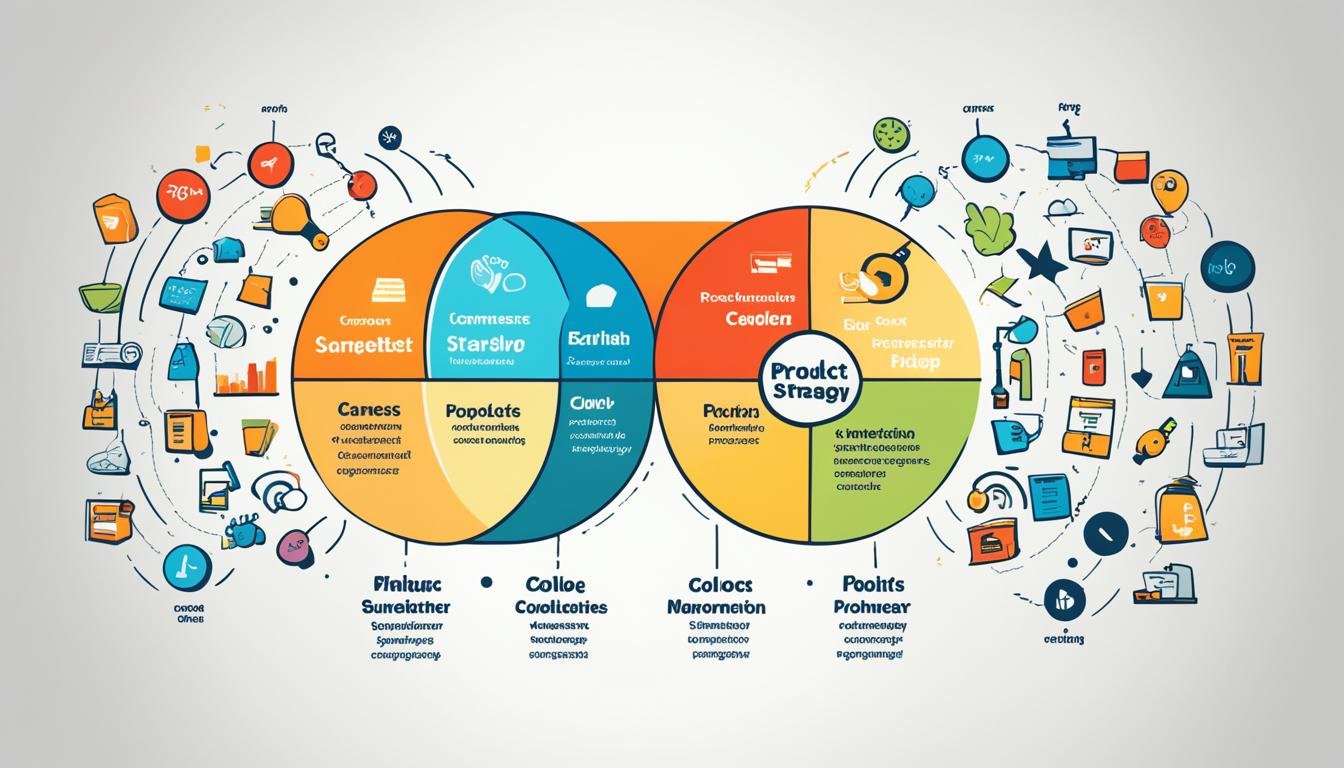Classic Marketing Theories: An Overview
Did you know that the Greek philosopher Plato talked about marketing over 2,500 years ago? The study of marketing is a young field, starting about 50 years ago. Yet, its history goes way back to the basics of trade.
From ancient markets to today’s digital world, marketing theories have changed a lot. They help businesses stay ahead in the game. Theories like the 4Ps of Marketing, SWOT Analysis, and Ansoff’s Matrix are still key today, even with all the new tech and changes in what people want.
Key Takeaways
- Classic marketing theories date back to ancient philosophies and have significantly influenced modern marketing strategies.
- The 4Ps of Marketing, SWOT Analysis, and Ansoff’s Matrix are foundational frameworks in marketing education and practice.
- Marketing theories have evolved to include societal concerns and the effects of technological advances over the last 20 years.
- Understanding these theories helps businesses maintain a competitive advantage in rapidly changing markets.
- Modern marketing blends traditional principles with contemporary methods to maximize reach and impact.
Introduction to Classic Marketing Theories
Classic marketing theories are the building blocks of marketing over the years. They help us understand how consumers behave, how markets work, and how to plan strategies.
What are Classic Marketing Theories?
Theories like the 4Ps (Product, Price, Place, Promotion), Ansoff’s Matrix, and SWOT Analysis help marketers plan. They guide in developing products, entering markets, and gaining an edge over competitors. These strategic marketing frameworks are key in marketing education and practice. They offer timeless advice for making decisions.
The marketing mix, or the 7Ps, is a key strategy tool. It includes Product, Price, Place, Promotion, People, Process, and Physical Evidence. Each ‘P’ is crucial for a well-rounded marketing plan:
- Product: Covers design, quality, features, options, packaging, and positioning.
- Price: Deals with setting prices based on quality or competition.
- Place: Looks at where and how the product is sold, both online and offline.
- Promotion: Uses ads, social media, and PR to reach customers.
- People: Focuses on staff training and hiring to improve customer service.
- Process: Makes sure services are efficient and effective, considering logistics and customer service.
- Physical Evidence: Shows the quality of service or product, building trust with customers.
These elements show how classic theories still matter today. They adapt to new marketing needs.
Importance in Modern Marketing
Classic marketing theories are still vital today. Even with new tech and changing consumer habits, their core ideas keep working.
For example, Porter’s Five Forces model looks at things like supplier power and competition. It helps businesses understand the market better. This leads to smarter strategies. The Lean Analytics Stages framework helps startups grow by making data-driven choices.
In conclusion, classic marketing theories are essential for marketers. They offer structured approaches and new ideas for today’s marketing world.
The Marketing Mix: 4Ps and Beyond
The marketing mix has grown a lot since it was first introduced in 1960. E. Jerome McCarthy created the original 4Ps—Product, Price, Place, Promotion. These set the stage for marketing strategies. Now, the mix has grown to include more elements, especially for service marketing and a complete approach.
The Original 4Ps
The first 4Ps focused on four main areas of marketing. They include:
- Product: This part deals with the product’s core, quality, features, branding, and how easy it is to use.
- Price: Pricing sets what customers pay for the product. It includes strategies like value-based pricing, which matters for products that show off status.
- Place: This is about how products get to customers through distribution channels and being available when needed.
- Promotion: This is all about sharing the product’s benefits with the target market. It includes ads, sales deals, and PR.
The Extended 7Ps
Booms & Bitner added three more Ps in 1981 to the original mix. These new elements are key for service marketing and focusing on customers.
- People: This part highlights how important people are in service marketing. It talks about training staff and managing customer service.
- Processes: Good processes make sure services are reliable and efficient. This makes customers happier.
- Physical Evidence: This is about what customers see and touch, like the building, equipment, and other parts of the brand.
The extended marketing mix gives a deeper and more detailed plan for today’s marketing. By using these elements, marketers can make strategies that cover both products and services. The goal is to create a full approach that boosts sales, builds brand awareness, and keeps customers coming back.
Ansoff’s Matrix: Strategic Development
The Ansoff Matrix is a key tool for marketing. It helps identify and check strategic growth models through four main strategies. These strategies—Market Penetration, Product Development, Market Development, and Diversification—help businesses find new chances for growth and handle risks. It’s advised to use the Ansoff Matrix yearly in strategic planning.
Market Penetration
Market Penetration aims to sell more of the same products in the same market. It’s seen as the safest strategy. For example, Coca-Cola increased its sales by 13% with seasonal marketing, like Christmas campaigns. The aim is to grow market share and keep customers loyal.
Product Development
Product Development means making new products for the current market. It’s a bit risky but can bring big rewards. McDonald’s launched the McSalad to draw in health-conscious customers. This way, companies can innovate and add more value to their market.
Market Development
Market Development is about selling existing products in new markets. It’s a bit risky but can lead to big growth. Coconut Water, for instance, got a 6% market share by targeting new customers. Companies often use online to enter new markets and reach different people.
Diversification
Diversification is the riskiest, involving new products in new markets. But it can bring huge growth and expansion. Apple’s move into mobile phones with the iPhone is a great example of successful diversification. There are two kinds—Related and Unrelated Diversification—both need deep market analysis and careful planning to reduce risk and increase benefits.
Using the Ansoff Matrix helps companies check their growth models and diversification strategies. This ensures they’re ready to grab new chances and keep growing over time.
SWOT Analysis: A Strategic Tool
SWOT analysis has been key in strategic planning for over 50 years. It helps organizations spot their organizational strengths, weaknesses, chances, and threats. By looking at internal and external factors, companies can make smart choices for growth and lasting success.
SWOT analysis is great for spotting new chances in the market. It shows where companies can use their strengths to grab new opportunities. At the same time, it helps tackle weaknesses and avoid threats. This way, companies are ready to face competition.
But, SWOT analysis is often seen as too general. To fix this, use it when you know exactly what you’re looking for. This focus lets you deeply look at the internal and external factors that really affect your decisions.
SWOT analysis also encourages teamwork. By getting different people involved, companies create a place where everyone shares ideas and worries. This teamwork builds trust and brings together many viewpoints for better planning.
Using SWOT analysis often helps companies see how they’re doing over time. It lets them use new chances and watch out for threats. By keeping their SWOT up to date, businesses can stay ahead and succeed in the long run.
Product Life Cycle: Stages of Market Growth
The product life cycle has four stages: Introduction, Growth, Maturity, and Decline. Each stage brings its own set of challenges and opportunities. By understanding these stages, businesses can plan better, use resources wisely, and manage their brand well.
Introduction Stage
The introduction stage needs a lot of marketing and product development effort. Costs are high as companies try to make people aware of their products and get into the market. Sadly, about 95% of new products don’t make it, showing how important a good plan and launch are.
Netflix is a great example. It started off slow but then grew huge, with 167 million subscribers now. Listening to customers and using new marketing ideas is key in this stage.
Growth Stage
In the growth stage, sales and revenue go up. This is when companies grow their market share. Marketing moves from just making people aware to making the brand stand out from others.
Dollar Shave Club’s famous video got 30 million views and brought in 12,000 orders in just two days. A strong product plan here can keep sales growing.
Maturity Stage
The maturity stage is usually the most profitable. Costs go down, but competition gets fierce. Companies need to keep innovating to stay ahead. This stage is all about being efficient and keeping profits up.
Nintendo is a great example of success here. They keep coming up with new ideas and re-releasing their hit games on different platforms. This keeps their products alive longer. Managing a brand well is key in this stage.
Decline Stage
In the decline stage, sales drop because the market is full and new products compete. Companies have to choose to stop making the product, find new uses for it, or make it better.
Using the Boston Consulting Group (BCG) Matrix can help make tough decisions in this phase. Keeping an eye on things and being flexible are important to fight decline and manage the brand well.
Porter’s Five Forces: Understanding Competition
Porter’s Five Forces model helps us see the competitive forces and how profitable a market can be. Michael E. Porter created it in 1980. It shows what makes competition and profits happen.
Threat of New Entrants
New competitors can change the game in a market. If entering a market is hard because of big costs, size needs, and rules, new companies might not come in. But if it’s easy to start, many new companies can enter, making it harder to make money.
Bargaining Power of Suppliers
Suppliers have a big impact on the market. If a few suppliers control the market, or their products are special and hard to switch, they have more power. They can set prices and terms, which affects how much money companies make.
Bargaining Power of Buyers
Buyers can also have a lot of power. If they buy a lot or have other options, they can push for better deals. This makes companies lower prices or improve their products to keep customers.
Threat of Substitute Products or Services
Substitute products or services can be a big threat. If they offer a good deal and are easy to switch to, they can take customers away. This can hurt how profitable the industry is.
Industry Rivalry
When many companies compete for customers, things get intense. This is even more true in slow-growing markets where companies fight over customers with lower prices or more ads. High costs and barriers to leave the market make it key for companies to keep innovating and standing out.
Maslow’s Hierarchy of Needs in Marketing
Maslow’s Hierarchy of Needs is a theory that shows five levels of human needs in a pyramid. Abraham Maslow first shared this idea in 1943. It’s now used in many fields, including marketing. By looking at what drives people, marketers can make better strategies and target their messages well.
Basic Needs
At the bottom of the pyramid, basic needs are about survival and safety. These include things like food, water, shelter, and feeling safe. Brands like Purell use these needs by showing how their products keep people healthy and safe.
Psychological Needs
Psychological needs are about feeling part of a group and being respected. People want to connect with others and feel important. Brands like Facebook and Instagram help people do this by making it easy to share and connect with friends.
Products that make people feel special, like luxury cars or designer clothes, also tap into these needs. They use smart marketing to reach people’s deep desires.
Self-fulfillment Needs
At the top of the pyramid, self-actualization is about reaching one’s full potential. Products that help people grow creatively or improve themselves do well here. For example, online courses like Coursera or MasterClass aim to help people get better and reach their goals.
By understanding these deep desires, marketers can make ads that really speak to people. This way, their messages match what their audience truly wants.
Boston Consulting Group Matrix: Portfolio Management
The Boston Consulting Group Matrix, also known as the BCG matrix, is a tool for analyzing products. It puts products into four groups based on their market share and growth rate:
- Stars: These are high-growth, high-market-share products. For example, Apple’s iPhone made $200.58 billion in 2023. It’s a star product needing ongoing investment to stay on top and bring in profits.
- Cash Cows: These products have a strong market share but grow slowly. Apple’s Mac products, like the MacBook, made $29.36 billion. They aim to make more money with little new investment.
- Question Marks: These products have growth potential but a small market share. They need a lot of investment to possibly become stars. Apple TV streaming service, with $85.2 billion in sales in 2023, is still a question mark.
- Dogs: These products have low growth and market share. Though usually advised to cut them, some can still make money with little cost. Apple’s iPad, with $28.3 billion in sales in 2023, is seen as a dog.
Looking at *strategic business units* in the Boston Consulting Group Matrix, Marks & Spencer is a good example. Their lingerie line is a star, their food line a question mark, the classic range a cash cow, and the high-fashion Autograph range a dog.
The Boston Consulting Group Matrix is also used for marketing channels to help allocate resources well.
This model was introduced in 1970 and many companies use it. At its peak, about half of all Fortune 500 companies used the BCG growth share matrix. It’s simple but some say it doesn’t work well for small businesses. Still, it’s a key tool for understanding how to grow market share in strategic business units.
Consumer Behavior and Decision Making Process
Understanding how consumers make decisions is key for marketers. This process includes stages like Problem Recognition, Information Search, and Purchase Decision. These stages help us understand what drives buying habits and how to influence them.
Problem Recognition
The first step is Problem Recognition. This is when a consumer feels they need something. It could be because they’re hungry or saw an ad. This sets the stage for their buying journey.
Information Search
Next, consumers look for information to solve their problem. They use search engines to learn about products and compare them. It’s important to process information well here, as they look at things like features and reviews.
Evaluation of Alternatives
Then, consumers weigh their options. They think about things like price and quality. They might go back and forth between searching for info and comparing products to make the best choice.
Purchase Decision
Finally, they decide to buy something. This choice can be based on logic, feelings, or marketing. Brands that help consumers through the early stages often get more sales.
Post-purchase Behavior
After buying, how happy the customer is matters a lot. Happy customers become loyal and recommend the brand. But unhappy customers might not come back. It’s important to keep an eye on how customers feel after buying to keep them coming back.
Brand Positioning and Market Segmentation
Brand positioning and market segmentation are key strategies. They help businesses find their unique spot in customers’ minds compared to rivals. By focusing on specific customer needs or behaviors, companies can better target their audience. This boosts competitive positioning and market differentiation.
The STP process (Segmentation, Targeting, and Positioning) is becoming more popular. It helps brands create personalized experiences. These personalized experiences are what 59% of customers look for when shopping and what 44% say would make them buy again.
Stagecoach UK Bus uses market segmentation well. They send special marketing messages to their two million daily passengers. Customer happiness comes from things like being reliable, comfortable, and offering good value.
Brands like Coca-Cola and Arm & Hammer are great at targeting certain groups. Coca-Cola made Coke Zero for health-conscious men. Arm & Hammer found new customers by showing many uses for their baking soda. This focused strategy helps with competitive positioning and builds strong brand loyalty.
In the end, focusing on detailed targeting and market segmentation is smart. It helps with standing out in the market and growing sustainably. It also makes a brand stronger in the market.
Classic Marketing Theories in Modern Context
Classic marketing theories are still key in today’s marketing strategies. They have adapted well to new formats. This helps businesses navigate the complex world of digital marketing integration and changing consumer habits.
Old marketing methods like business cards and TV ads are still used but have limits. They don’t offer much interaction. Newer strategies like email marketing and social media are more flexible. They help businesses reach out to people in new ways.
“Email marketing is highlighted for its highest ROI among various marketing channels.”
Using digital marketing can bring better results and engage customers more deeply. It’s also more cost-effective than old methods. But, it does require some tech skills. The benefits include a higher return on investment and better targeting.
Traditional marketing is easy to grasp and reaches people locally. But, it doesn’t offer much interaction or targeting. Modern marketing, through social media or automation, focuses on making customers happy. It uses strategies to draw in audiences.
Now, marketing focuses more on building long-term relationships with customers. It allows for ongoing promotions and targeting specific groups. This approach also opens up the market to a global audience.
Companies must think about their budget and goals when picking between old and new marketing ways. Current market trends show the need to find and target the right audience. This means looking at things like age, location, and industry to choose the best marketing strategy.
Looking at classic marketing theories through a modern lens shows they still have core principles. But, how we apply them has changed to fit today’s digital world.
Conclusion
Marketing strategy development is built on timeless marketing principles from classic theories. Over seventy-five years, the field has grown a lot, thanks to industry publications and trade journals. These sources have taught us a lot about market behavior, competition, and understanding customers.
The marketing mix, which includes product, price, distribution, and promotion, is key to understanding markets. It helps in making strong marketing strategies. Looking at how companies like Marlboro, Perrier, and Mercedes-Benz use these strategies shows their lasting value.
Since the late fifties, marketing research has become vital. It helps in segmenting customers and testing new ideas. New theories like the Resource-Advantage (R-A) theory and sustainable development show the need for a flexible marketing approach. These ideas help balance company growth with customer needs and inclusivity.
Source Links
- evolution of marketing [theory] | The Marketing Concept
- Traditional Vs Contemporary Marketing Strategies
- 6 important marketing theories—and how to apply them in social media campaigns
- The 9 Best Marketing Frameworks You Need to Know
- Marketing Mix and The 7 Ps of Marketing | Mailchimp
- Marketing Mix: The 4 Ps of Marketing and How to Use Them
- Marketing Theories – The Marketing Mix – From 4 Ps to 7 Ps
- The Ansoff Model [Marketing strategy matrix] | Smart Insights
- The Ansoff Matrix: 4 Growth Strategies Explained (With Examples)
- Ansoff Matrix
- It’s Time to Toss SWOT Analysis into the Ashbin of Strategy History
- What is a SWOT Analysis? Definition, Method, and Examples
- SWOT analysis
- Product Life Cycle Explained: Stage and Examples
- How to use the Product Life Cycle (PLC) marketing model | Smart Insights
- The Product Lifecycle and Innovation-Adoption Curve
- Porter’s Five Forces Explained and How to Use the Model
- The Five Forces – Institute For Strategy And Competitiveness
- Porters 5 Forces
- Maslow’s Hierarchy of Needs: How It Can Help Your Marketing
- Marketing Theories – Maslow’s Hierarchy of Needs
- How to use the BCG Matrix | Smart Insights Digital Marketing
- Understanding the BCG Growth Share Matrix and How to Use It
- Marketing Theories: the Consumer Decision Making Process
- Chapter 2 – Review of decision making models
- Marketing models that have stood the test of time [Free guide]
- The Complete Guide to STP Marketing: Segmentation, Targeting & Positioning | Yieldify
- MARK_A01.indd
- What’s the Difference – Modern Marketing vs Traditional Marketing
- Difference between Traditional Marketing Concept and Modern Marketing Concept – GeeksforGeeks
- A Normative Theory of Marketing Practice – Jagdish Sheth
- General Theory of Marketing – A More Sustainable Approach
- Marketing Strategy: the Definition, Theory and Types







